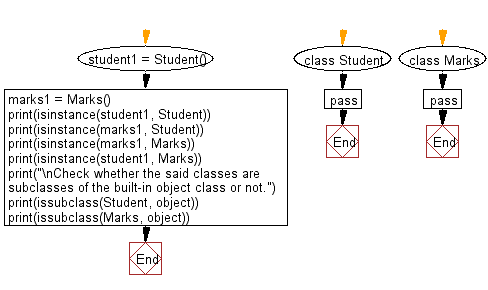Python: Check instances and in subclasses a given class
Python Class ( Basic ): Exercise-8 with Solution
Write a Python program to crate two empty classes, Student and Marks. Now create some instances and check whether they are instances of the said classes or not. Also, check whether the said classes are subclasses of the built-in object class or not.
Sample Solution:
Python Code:
class Student:
pass
class Marks:
pass
student1 = Student()
marks1 = Marks()
print(isinstance(student1, Student))
print(isinstance(marks1, Student))
print(isinstance(marks1, Marks))
print(isinstance(student1, Marks))
print("\nCheck whether the said classes are subclasses of the built-in object class or not.")
print(issubclass(Student, object))
print(issubclass(Marks, object))
Sample Output:
True False True False Check whether the said classes are subclasses of the built-in object class or not. True True
Flowchart:

Visualize Python code execution:
The following tool visualize what the computer is doing step-by-step as it executes the said program:
Python Code Editor:
Contribute your code and comments through Disqus.
Previous: Write a simple Python class named Student and display its type.
Next: Write a Python class named Student with two attributes student_name, marks. Modify the attribute values of the said class and print the original and modified values of the said attributes.
What is the difficulty level of this exercise?
Test your Programming skills with w3resource's quiz.
Python: Tips of the Day
Find current directory and file's directory:
To get the full path to the directory a Python file is contained in, write this in that file:
import os dir_path = os.path.dirname(os.path.realpath(__file__))
(Note that the incantation above won't work if you've already used os.chdir() to change your current working directory, since the value of the __file__ constant is relative to the current working directory and is not changed by an os.chdir() call.)
To get the current working directory use
import os cwd = os.getcwd()
Documentation references for the modules, constants and functions used above:
- The os and os.path modules.
- The __file__ constant
- os.path.realpath(path) (returns "the canonical path of the specified filename, eliminating any symbolic links encountered in the path")
- os.path.dirname(path) (returns "the directory name of pathname path")
- os.getcwd() (returns "a string representing the current working directory")
- os.chdir(path) ("change the current working directory to path")
Ref: https://bit.ly/3fy0R6m
- New Content published on w3resource:
- HTML-CSS Practical: Exercises, Practice, Solution
- Java Regular Expression: Exercises, Practice, Solution
- Scala Programming Exercises, Practice, Solution
- Python Itertools exercises
- Python Numpy exercises
- Python GeoPy Package exercises
- Python Pandas exercises
- Python nltk exercises
- Python BeautifulSoup exercises
- Form Template
- Composer - PHP Package Manager
- PHPUnit - PHP Testing
- Laravel - PHP Framework
- Angular - JavaScript Framework
- Vue - JavaScript Framework
- Jest - JavaScript Testing Framework
